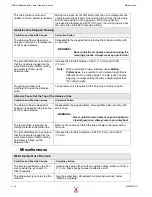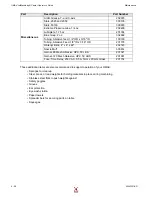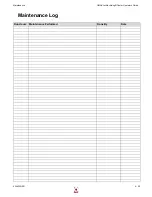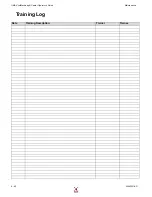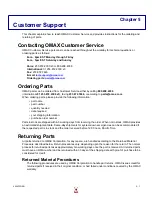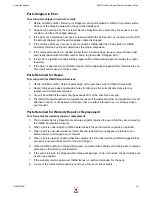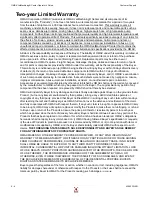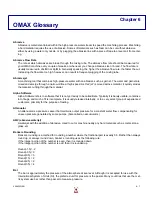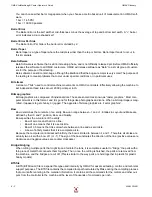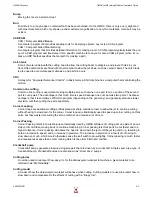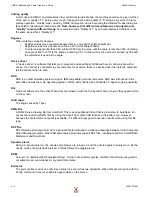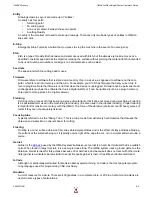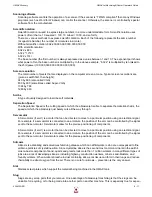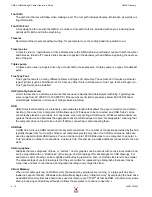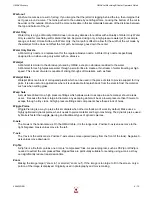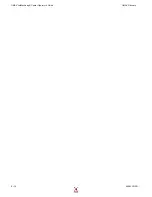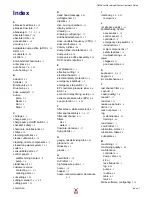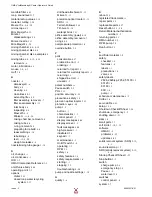
OMAX Glossary
OMAX JetMachining® Center Operator’s Guide
400433D-EN
6 - 3
Bump
Moving the nozzle a small amount
Burr
Burr refers to a rough edge on material that has been machined. On the OMAX, there is only a very slight burr
with most materials, which only shows up under extreme magnification. In very thin materials, more burr may be
evident.
CAD/CAM
CAD =
C
omputer
A
ided
D
esign
A computer program that provides drawing tools for designing objects. Layout is a CAD program.
CAM = Computer Aided Manufacturing
A computer program that provides detailed information for making a part. A CAM program typically takes the out-
put of a CAD program and translates it for a specific machine tool. Layout is also a CAM program (when it cre-
ates an ORD file that specifies the tool path for making a part).
Catch tank
A tank of water underneath the cutting head to allow the cutting beam to disperse, and prevent holes in your
floor. Often catch tanks are filled with other material to slow the jet down, such as ceramic balls. The catch tank
is also used to accumulate spent abrasive, and part drop outs.
CNC
Acronym for “Computer Numerical Control”. In basic terms a CNC machine has a computer that is controlling the
motion.
Common line cutting
Common line cutting is used when making multiple parts, so that when one part is cut, a portion of the second
part is cut as well. The advantage is that much time is saved, because one cut can make two parts. The disad-
vantage is that it is sometimes difficult to program (depending on the geometry), and generally produces lower
precision cuts than cutting the parts separately.
Corner Looping
Corner loops are additional cutting entities placed at sharp outside corners to allow the jet to continue cutting
without having to slow down for the corner. Corner loops are traditionally used to speed up corner cutting on thick
parts, but they waste time cutting the scrap material, and require a lot of room.
Corner Passing
Corner Passing refers to the technique automatically used by OMAX software of cutting past one side of an out-
side corner and then moving back to continue machining. Corner passing lets thick parts be cut faster and to a
higher tolerance. Corner passing eliminates the need to slow down the jet to let the jet lag catch up, resulting in
both an increase in speed, and an increase in precision. The increase in precision is a result of not having to
slow down so much, which would otherwise cause the kerf width to grow slightly. Corner passing is much faster
and requires less space than corner looping which is the older “alternate” method.
Crankshaft pump
Crankshaft pumps generate pressure using plungers that are driven by a crankshaft. A triplex pump is a type of
crankshaft pump. Crankshaft pumps are also known as “direct drive” pumps.
Cutting index
A number used to represent how easy it is for the abrasivejet or waterjet to machine a given material. Also
referred to as “Machinability.”
Cutting model
A model of how the abrasivejet or waterjet will behave when cutting. Cutting models are used to predict how to
slow down and compensate for the effects of cutting with a “floppy tool”.
Содержание JetMachining Center 2626
Страница 8: ...OMAX JetMachining Center Operator s Guide viii 400433D EN ...
Страница 12: ...OMAX JetMachining Center Operator s Guide xii 400433D EN ...
Страница 22: ...OMAX JetMachining Center Operator s Guide Safety First 1 10 400433D EN ...
Страница 140: ...OMAX JetMachining Center Operator s Guide OMAX Glossary 6 16 400433D EN ...
Страница 144: ...OMAX JetMachining Center Operator s Guide Index 4 400433D EN ...


